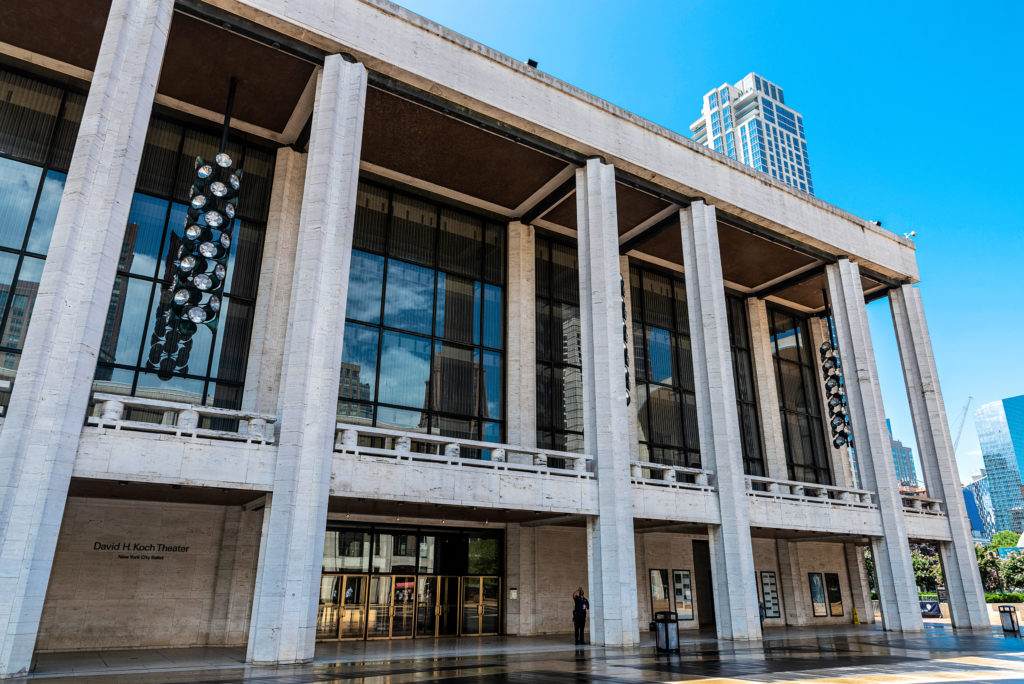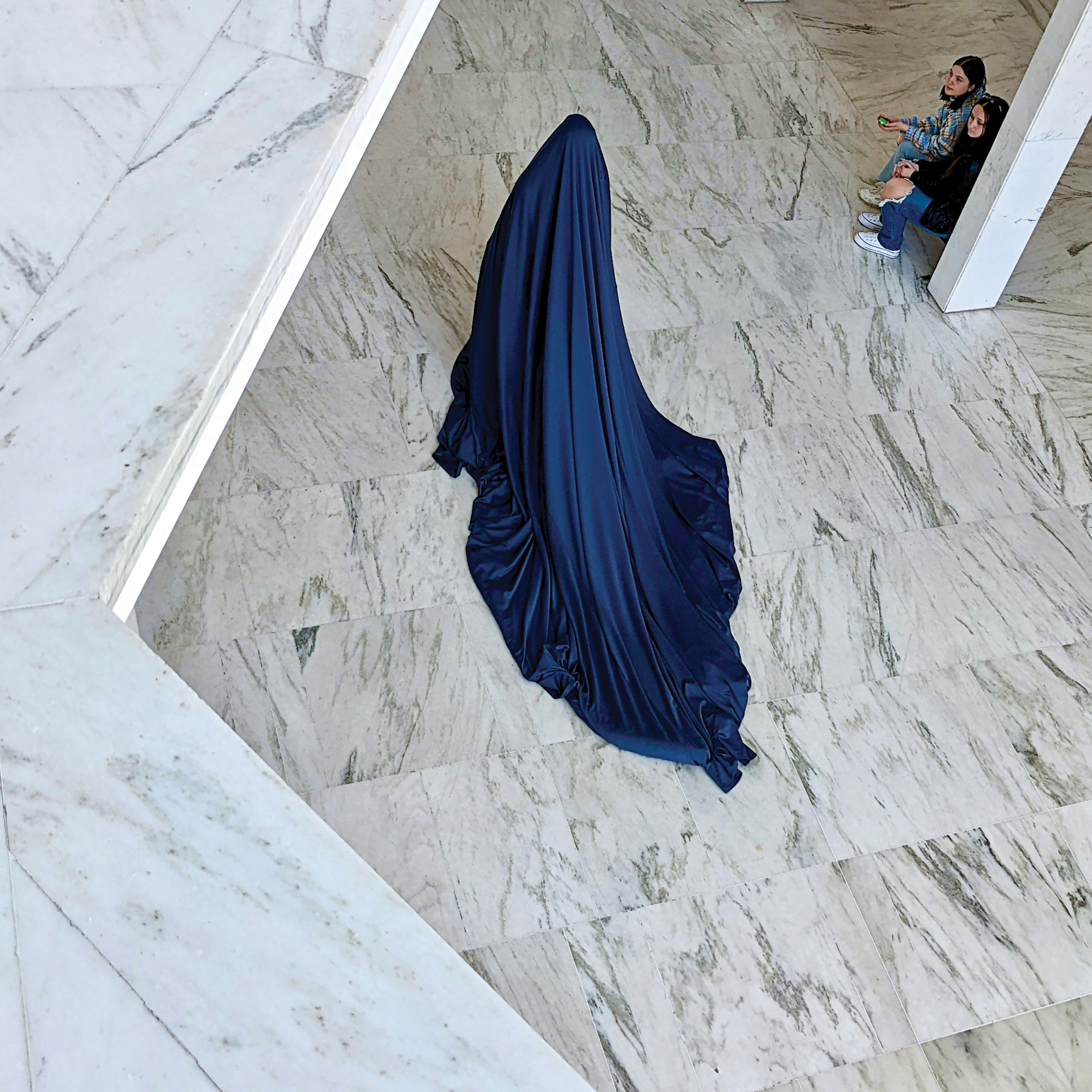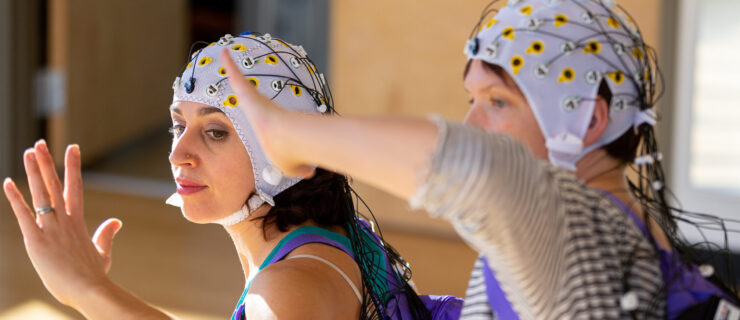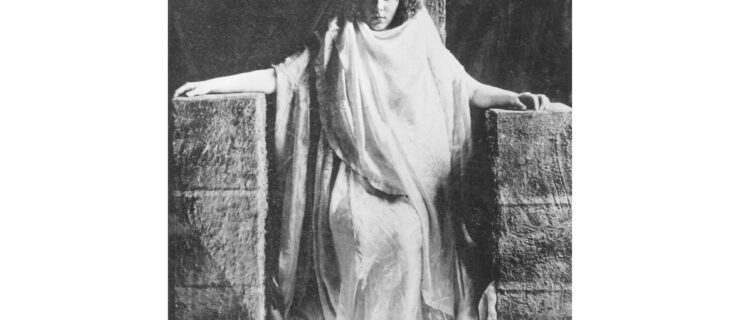Exploring Site-Specific Performance Here & Now
On a bright but chilly day in April 2022, choreographer Biba Bell and composer-director Joo Won Park premiered A DREAM IS A HOUSE for remembering the future. Created specifically for the McGregor Memorial Conference Center in Detroit, the hourlong performance by 21 dancers, nine musicians and Park embraced architect Minoru Yamasaki’s prismatic jewel box of marble and glass, built in 1958.
Taking advantage of the faceted atrium’s unusual acoustics, Park’s original score for electric guitar, percussion and eight laptop computers emanated from small amplifiers distributed throughout the skylit room, whose tall panels of teakwood resonated with every whisper and rhythm. At one point, the entire ensemble of dancers rushed from one end of the space to the other, as if the McGregor Center was a cruise ship rocking and rolling in turbulent seas. Cloud cover during the 3 o’clock performance brought somber qualities to the action, but, when repeated at 5 o’clock and lit vividly by the setting sun, it was an ascension.
Every dance is site-specific in some sense, but, in a warming world changed by war, political upheaval and a pandemic, some choreographers forgo traditional venues entirely. Whether their work is about climate change, social dynamics, systemic oppression or community vibrance, they’re all drawn to the friction between moving and staying in one place.
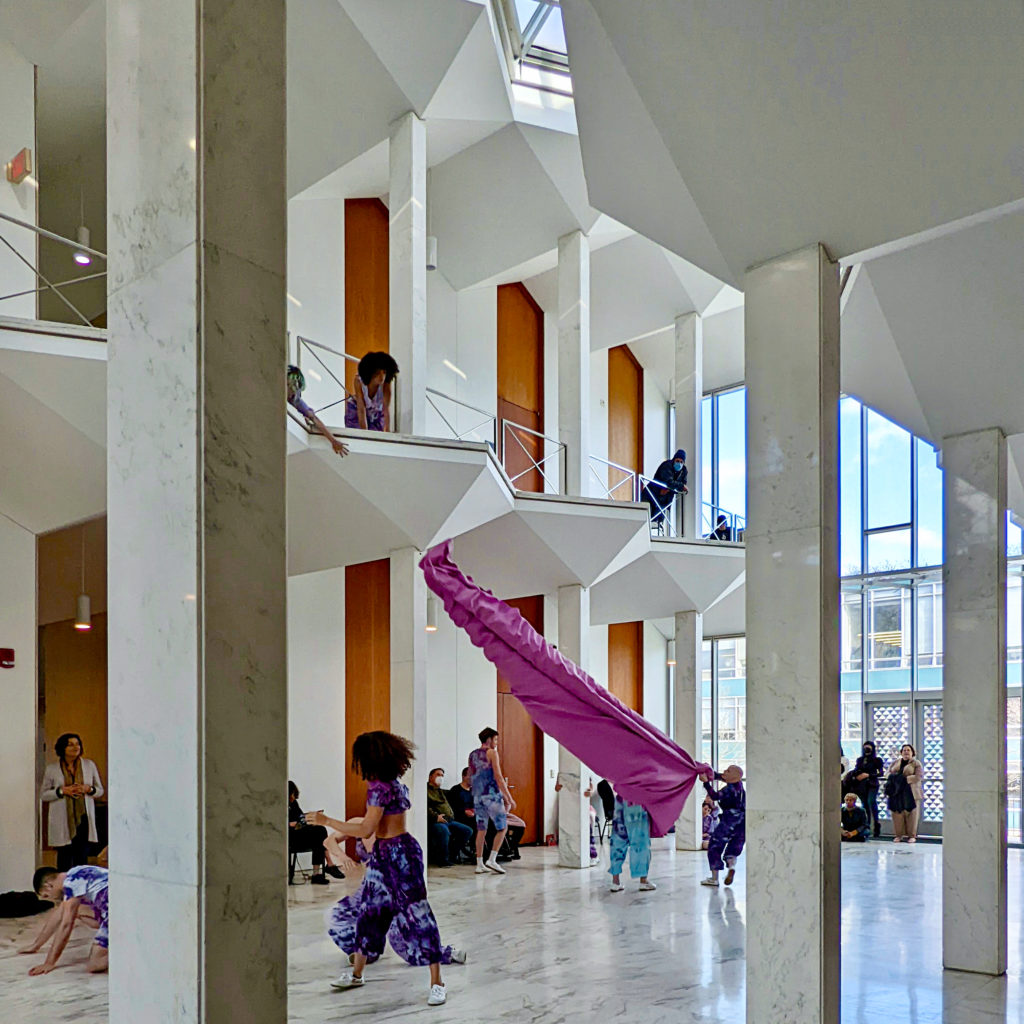
Fields of Infinite Potential
“Sites outside of a dance studio are fields of infinite potential that can be very generative as places we have relationships with,” says transmedia artist d. Sabela grimes, a professor at the USC Glorya Kaufman School of Dance, who grew up on California’s central coast and attended UCLA. While he lived and worked in Soweto, South Africa, and Philadelphia, grimes maintained a connection with the Leimert Park Village neighborhood of Los Angeles, where the community weaves performance—both planned and spontaneous—into daily life along Degnan Boulevard.
Before COVID-19 vaccines were available, “when we were all in our homes—do you remember?—I can’t explain to you how important it was, how valuable it was, how special it was, to be in public space with people making music, to see them dancing, to be in communion and fellowship,” grimes says. Even as in-person classes and shows resumed indoors, grimes stayed involved with the vibrant scene around Degnan Boulevard’s street vendors and businesses, like Anthony Jolly’s Hot and Cool Cafe and its adjacent alley. “The streets continue to be a driving force and wellspring of knowledge production and transmission,” he says. One night reminded grimes how performance can be not only site-specific but a way to bring the essence of one place to another: TOB, a band that plays go-go, a variant of funk music specific to the nation’s capital, played Leimert Park Village from a stage on top of a bus booked by Jolly and Long Live GoGo DC. Dancing ensued. “I had no idea so many people from Washington were living in L.A.,” says grimes, who remembers the southeast District well from summertime visits with his mother’s family. “It literally was like the spot turned into a street in DC.”
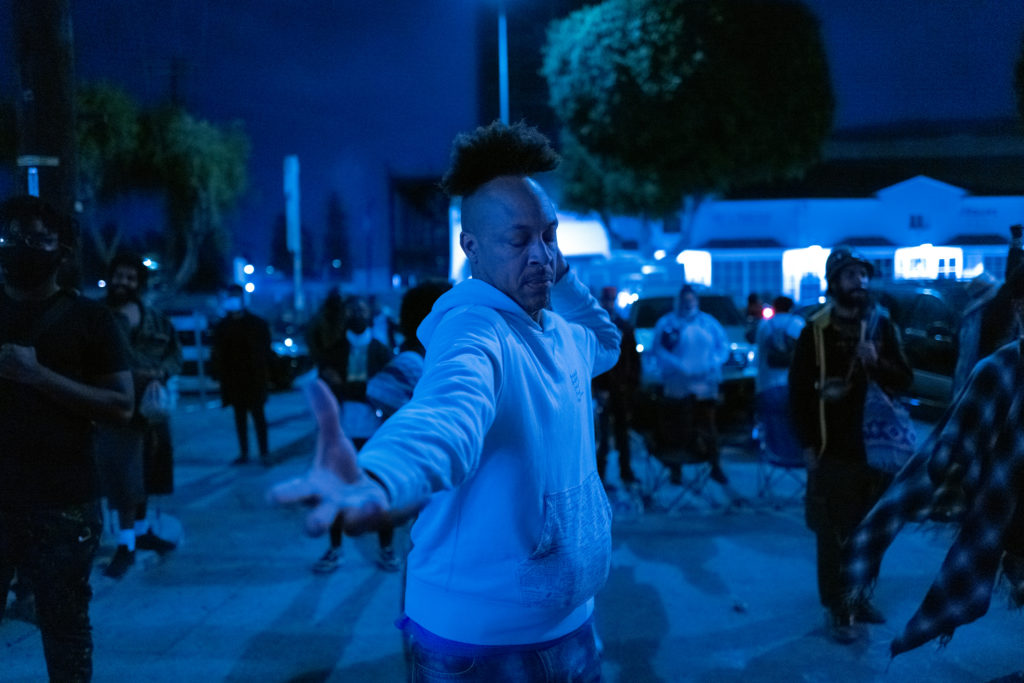
As a continuation of his series called Dark Matter Messages, grimes is currently developing PARABLE OF PORTALS (POP), supported by a National Dance Project production grant from the New England Foundation for the Arts. By applying augmented-reality technology to intentionally chosen, real-world locations, grimes says one question POP asks is, “How can the experience of dance happen in a variety of sites simultaneously?”
At a May 2022 work-in-progress showing in Chicago of reorientations, by SLIPPAGE resident artists Kate Alexandrite, who is white, and Thomas F. DeFrantz, Ayan Felix and MX Oops, who are Black, Alexandrite wore virtual-reality goggles while the other three interacted and made eye contact. The four artists might technically have shared space, but, experientially, Alexandrite was often somewhere else. A large screen periodically displayed a live feed of video from inside the goggles, revealing to the audience where Alexandrite “was” and what they were doing there.
Site as Body, Body as Site
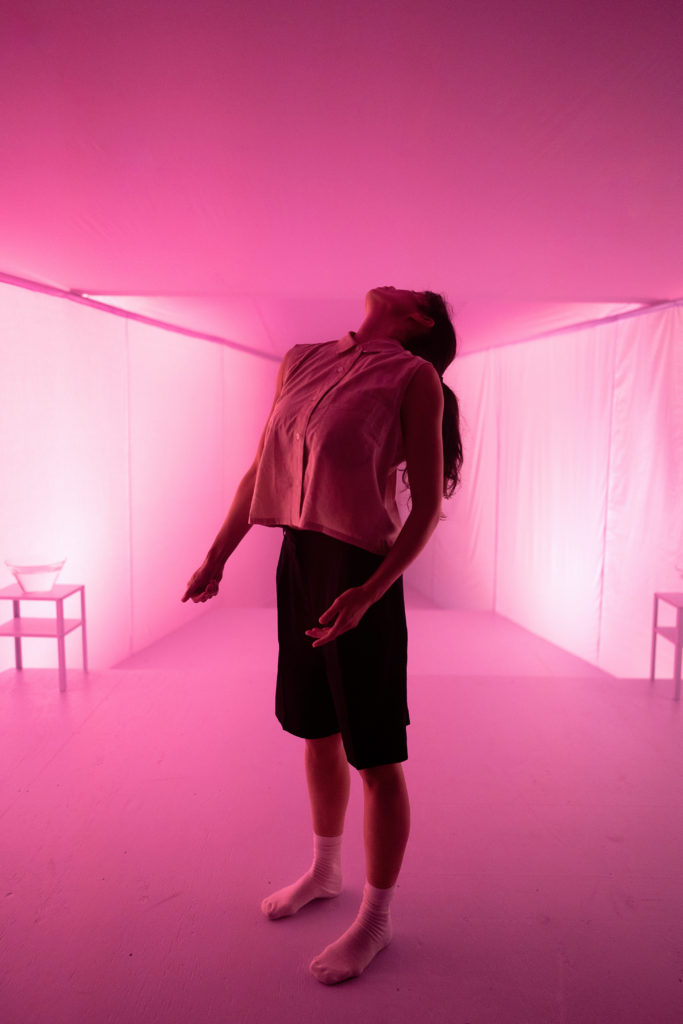
performance held in person and virtually. Photo by Robbie Sweeny, Courtesy FACT/SF.
As a choreographer of mixed European and Moose Cree First Nation ancestry, Starr Muranko’s work as co–artistic director of Raven Spirit Dance in the Canadian city of Vancouver is informed, she explains, by Indigenous values. “A lot of our research is land-based and takes place outside,” says Muranko. “Even though the work might eventually end up on a stage, it’s often rooted in a particular place or in going home.” For a piece titled Before7After, about seven generations of Cree women, Muranko traveled to an island in the Moose River in northern Ontario, 500 miles from Toronto. “The idea that I wouldn’t go back to the land for that project made no sense. How your body moves is influenced by certain surfaces, by the land around you, by the temperature, by the climate, by the time of year.” After developing material on location, Muranko and her collaborators sometimes return to the studio, where “we then have that landscape and that map within our bodies, as well as within the space. It’s not a ‘blank studio’ or a ‘blank theater.’ It’s where that river is, where that mountain is.”
In creating The Sky Was Different for Hubbard Street Dance Chicago’s Season 43: A Virtual Homecoming, the company’s 2020–21 virtual season, company alumni Jonathan Fredrickson and Tobin Del Cuore collaborated with Hubbard Street’s dancers on a 50-minute film, shot in and around the 1938 home and studio of architect Paul Schweikher in the Chicago suburb of Schaumburg. “For me, site-specificity is about utilizing a space by being aware of it and letting it dictate what happens,” says Fredrickson, a choreographer now based in Germany and a guest artist with Tanztheater Wuppertal Pina Bausch. “The house itself was a character, this body in which the dancers were its organs, its bloodstream, its brain, its heart. The narrator of the piece was the house itself.” In long, meticulously choreographed takes, Del Cuore’s eye-level camera glides through the house’s rooms, giving The Sky Was Different a sense of actively involved curiosity reminiscent of movies like Roma, by Alfonso Cuarón.
Fredrickson choreographed a solo for Alvin Ailey American Dance Theater’s Jamar Roberts in director Bram VanderMark’s I Carry Them, produced by Jacob Jonas The Company. Released in May 2022, the five-minute film uses an editing technique called cross-cutting to move Roberts from place to place, while his fluid dancing continues uninterrupted.
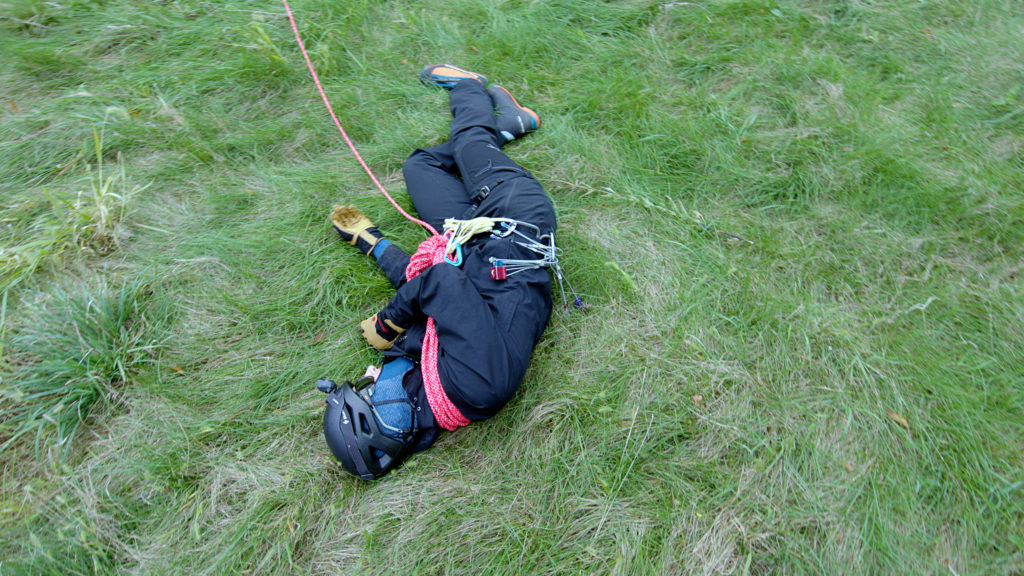
Site as Signifier
In addition to honoring or recontextualizing a place, site-informed performance can be a way to raise awareness of threats to a community’s existence, says Millicent Johnnie, founder and CEO of Millicent Johnnie Films and chief visionary producer at 319 productions. In 2013, Johnnie and her collaborators, including New Orleans–based companies ArtSpot Productions and Mondo Bizarro, won a Creative Capital Award to develop Cry You One, which addressed the impact of climate change on wetlands in southeast Louisiana. “I’d always done site-specific studies and generated choreography in connection with the land,” Johnnie says, “but Cry You One is when I really started to sink into making dance in relation to site and started using the term ‘site-responsive,’ which was introduced to me by Mondo Bizarro, which came from the principle ‘You cannot walk into a space and impose yourself on that space.’ ” Johnnie says that Cry You One asked the question “What happens to art and culture that’s tied to land when that land disappears?” After premiering in St. Bernard Parish, the project toured for two years, bringing with it the artists’ embodied knowledge of its source.
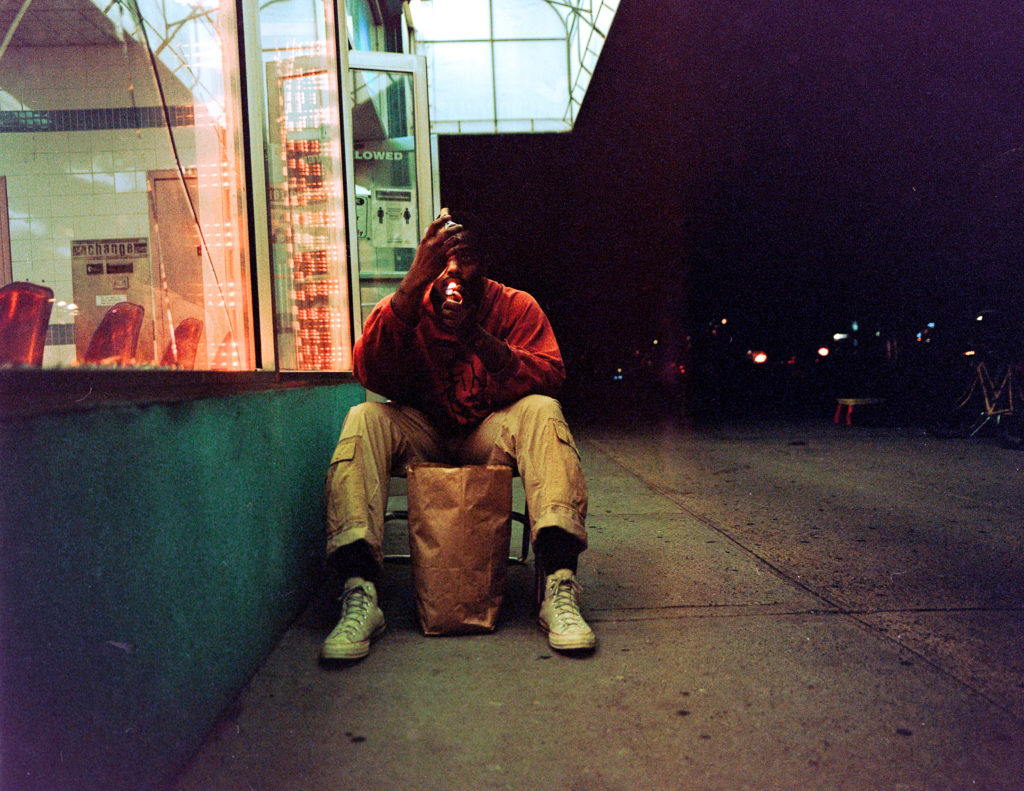
Sometimes, site-specific research plants seeds for works that bloom elsewhere. During the four years Johnnie lived in Rio de Janeiro, Brazil, she would often visit the Tijuca rainforest to write, improvise movement and develop studies for future projects. When Toshi Reagon, then the festival curator for the Women’s Jazz Festival at the Schomburg Center for Research in Black Culture, paired Johnnie with Ethiopian American musician Meklit Hadero, “that wasn’t intended to be a site-responsive work,” Johnnie says, “but there were certain sounds and textures I kept hearing in Meklit’s music that paralleled sounds and textures from the Tijuca rainforest. That helped me create and build the world that I needed to improvise with Meklit.” Johnnie recently collaborated with Urban Bush Women founding artistic director Jawole Willa Jo Zollar on Where Water Is Not Thirsty, responsive to Tallahassee, Florida’s Lafayette Heritage Trail Park and Lichgate on High Road, and captured on video by a camera built into a remote-controlled drone.
Before the pandemic, the Bay Area dance company FACT/SF presented work in both traditional dance venues and places that resist the ways dancers’ bodies can be abstracted, generalized or objectified onstage. For Invidious, a sextet custom-created in 2014 for a patron’s San Francisco home, choreographer and artistic director Charles Slender-White staged solos in the bathroom and kitchen, and duets in the bedroom and living room. Audiences of 16 people at a time, divided into four groups of four, encountered these dances at different times, making each attendee’s experience of Invidious fairly unique—and each role an exercise in energy modulation.
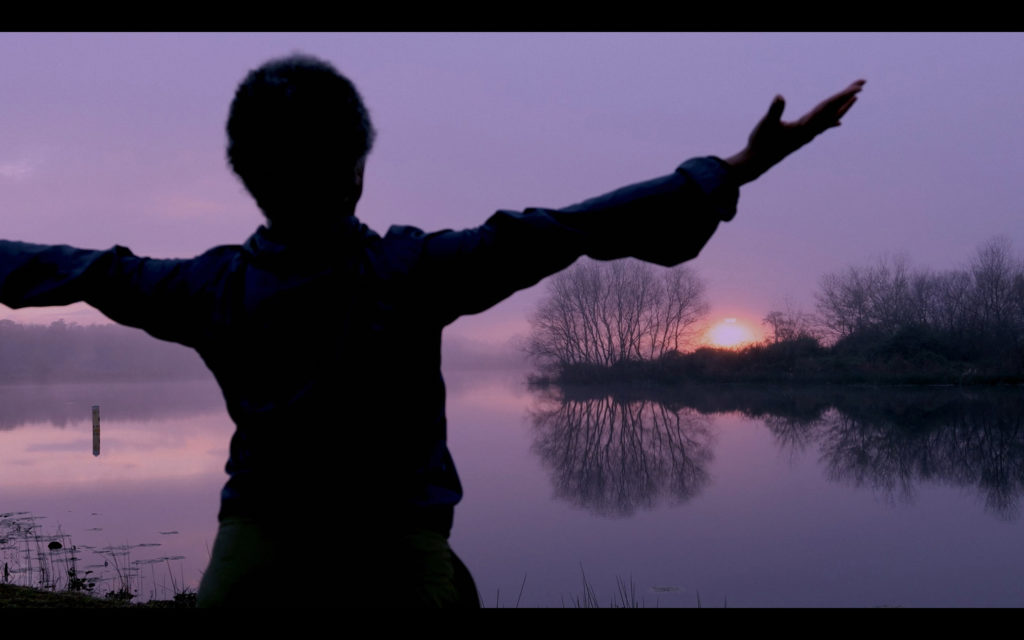
“We talk a lot in our practice about adopting a disposition that allows people to view you, not as a set of ideas or shapes or even kinetic factors, but as a person, occupying the same space,” says Slender-White. “When the dancers do that, it invites the audience in and then, probably because of mirror neurons and social empathy, the exchange becomes more generous and supportive.” Since FACT/SF uses live performance to investigate group dynamics, Slender-White says the company is continuously challenged by the ongoing, ever-evolving COVID-19 pandemic. “The relationship between an individual’s concept of self and experience of self, and the way that those things interplay with others’ perspectives or perceptions of self, have been central to my work since the beginning.” The fall 2021 premiere run of FACT/SF’s Split comprised 248 performances for audiences of one, present either in person or virtually.
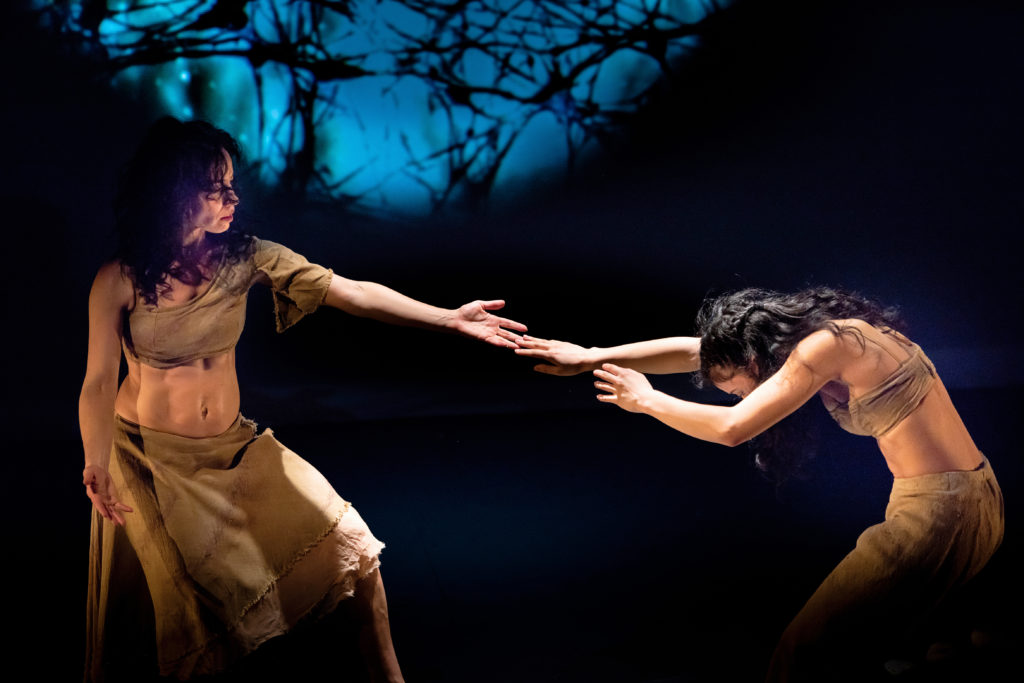
Exploring sites of a certain type can prompt touring pathways outside the presenting networks that link similarly sized, like-minded venues. The Consumption Series: Part II brought Slender-White and FACT/SF colleague Emily Woo Zeller to every single Walmart store in the state of California—173 at the time. But that project wasn’t about the stores themselves, Slender-White explains. “We weren’t really interested in the structures, the cars in the parking lots, the lighting fixtures over the aisles,” he says. “It was specific to a certain context, a type of sociocultural site, an economic site, a site of commerce, where we could ask, ‘What is happening here?’ ”
They Got Out—But Will They Stay Out?
Dance companies large and small pivoted to site-specific, digital filmmaking as part of their pandemic responses. At New York City Ballet, this widened the spotlight to showcase more of the company’s home, the David H. Koch Theater, than just its storied stage. New works in 2020 and 2021 by choreographers Kyle Abraham, Sidra Bell, Andrea Miller, Justin Peck, Jamar Roberts and Pam Tanowitz brought at-home viewers backstage, into pools in the plaza at Lincoln Center, and up to the ceiling of the theater’s Promenade to look straight down on dancers below—a screen-based amalgam of Modernist architecture, Busby Berkeley and contemporary ballet. Time will tell whether major dance institutions continue such location-based experimentation.
